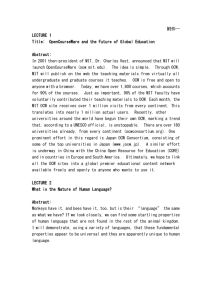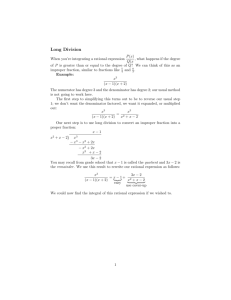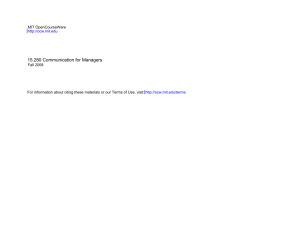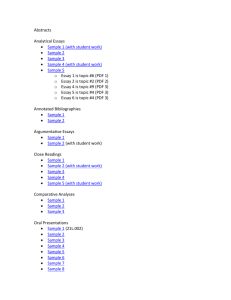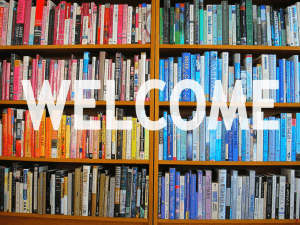2005 Program Evaluation Findings Summary
advertisement
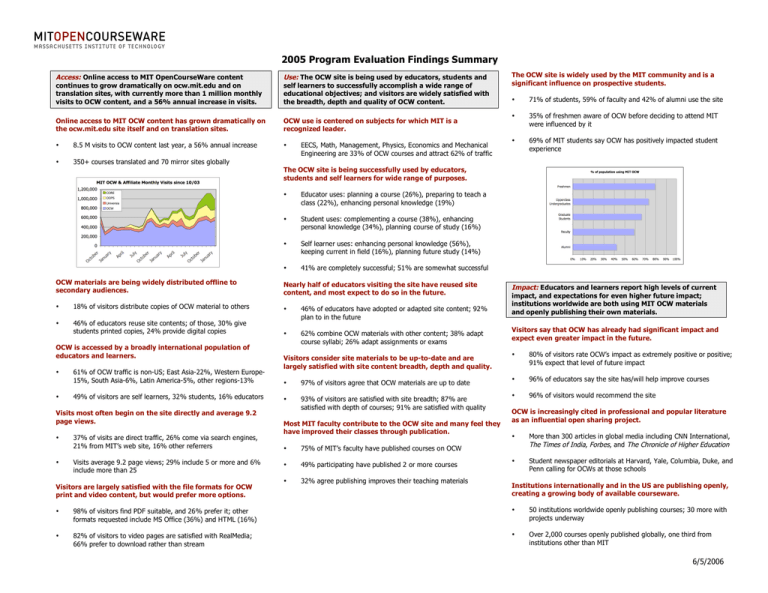
2005 Program Evaluation Findings Summary Access: Online access to MIT OpenCourseWare content continues to grow dramatically on ocw.mit.edu and on translation sites, with currently more than 1 million monthly visits to OCW content, and a 56% annual increase in visits. Use: The OCW site is being used by educators, students and self learners to successfully accomplish a wide range of educational objectives; and visitors are widely satisfied with the breadth, depth and quality of OCW content. The OCW site is widely used by the MIT community and is a significant influence on prospective students. • 71% of students, 59% of faculty and 42% of alumni use the site Online access to MIT OCW content has grown dramatically on the ocw.mit.edu site itself and on translation sites. OCW use is centered on subjects for which MIT is a recognized leader. • 35% of freshmen aware of OCW before deciding to attend MIT were influenced by it • 69% of MIT students say OCW has positively impacted student experience • 8.5 M visits to OCW content last year, a 56% annual increase • 350+ courses translated and 70 mirror sites globally OCW materials are being widely distributed offline to secondary audiences. • EECS, Math, Management, Physics, Economics and Mechanical Engineering are 33% of OCW courses and attract 62% of traffic The OCW site is being successfully used by educators, students and self learners for wide range of purposes. • Educator uses: planning a course (26%), preparing to teach a class (22%), enhancing personal knowledge (19%) • Student uses: complementing a course (38%), enhancing personal knowledge (34%), planning course of study (16%) • Self learner uses: enhancing personal knowledge (56%), keeping current in field (16%), planning future study (14%) • 41% are completely successful; 51% are somewhat successful Nearly half of educators visiting the site have reused site content, and most expect to do so in the future. • 18% of visitors distribute copies of OCW material to others • • 46% of educators reuse site contents; of those, 30% give students printed copies, 24% provide digital copies 46% of educators have adopted or adapted site content; 92% plan to in the future • 62% combine OCW materials with other content; 38% adapt course syllabi; 26% adapt assignments or exams OCW is accessed by a broadly international population of educators and learners. • • 61% of OCW traffic is non-US; East Asia-22%, Western Europe15%, South Asia-6%, Latin America-5%, other regions-13% 49% of visitors are self learners, 32% students, 16% educators Visits most often begin on the site directly and average 9.2 page views. • • 37% of visits are direct traffic, 26% come via search engines, 21% from MIT’s web site, 16% other referrers Visits average 9.2 page views; 29% include 5 or more and 6% include more than 25 Visitors are largely satisfied with the file formats for OCW print and video content, but would prefer more options. Visitors consider site materials to be up-to-date and are largely satisfied with site content breadth, depth and quality. Impact: Educators and learners report high levels of current impact, and expectations for even higher future impact; institutions worldwide are both using MIT OCW materials and openly publishing their own materials. Visitors say that OCW has already had significant impact and expect even greater impact in the future. • 80% of visitors rate OCW’s impact as extremely positive or positive; 91% expect that level of future impact • 97% of visitors agree that OCW materials are up to date • 96% of educators say the site has/will help improve courses • 93% of visitors are satisfied with site breadth; 87% are satisfied with depth of courses; 91% are satisfied with quality • 96% of visitors would recommend the site Most MIT faculty contribute to the OCW site and many feel they have improved their classes through publication. • 75% of MIT’s faculty have published courses on OCW • 49% participating have published 2 or more courses • 32% agree publishing improves their teaching materials OCW is increasingly cited in professional and popular literature as an influential open sharing project. • More than 300 articles in global media including CNN International, The Times of India, Forbes, and The Chronicle of Higher Education • Student newspaper editorials at Harvard, Yale, Columbia, Duke, and Penn calling for OCWs at those schools Institutions internationally and in the US are publishing openly, creating a growing body of available courseware. • 98% of visitors find PDF suitable, and 26% prefer it; other formats requested include MS Office (36%) and HTML (16%) • 50 institutions worldwide openly publishing courses; 30 more with projects underway • 82% of visitors to video pages are satisfied with RealMedia; 66% prefer to download rather than stream • Over 2,000 courses openly published globally, one third from institutions other than MIT 6/5/2006
